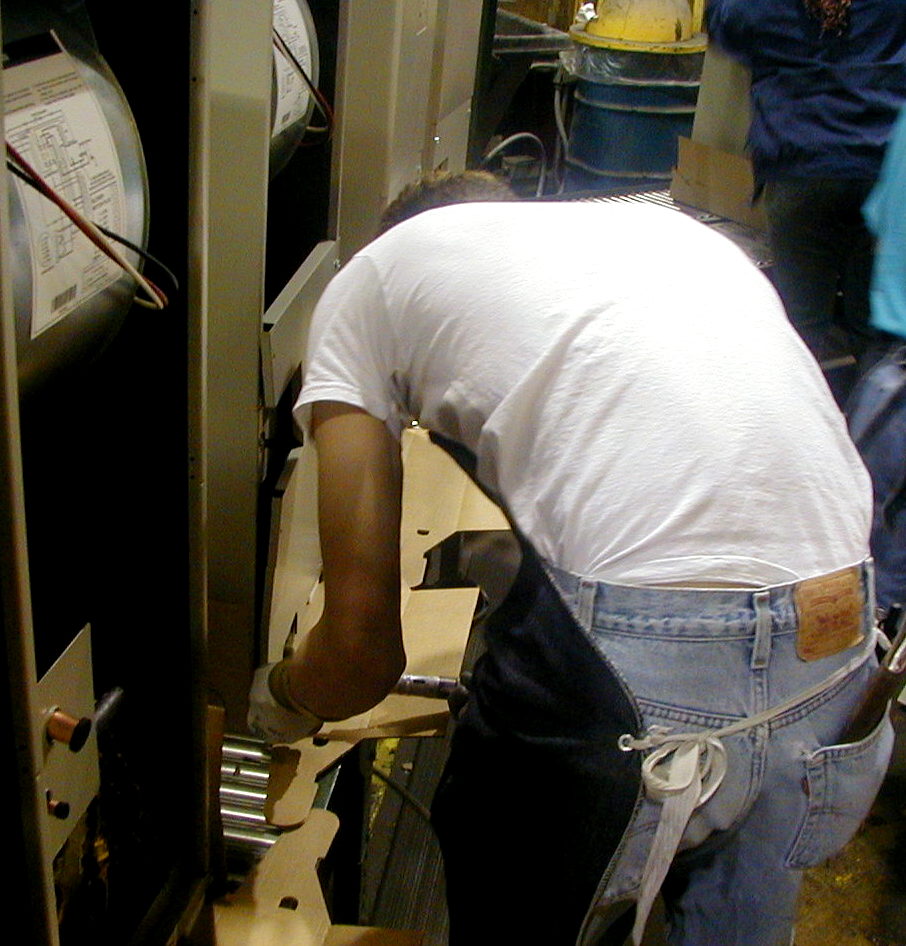 |
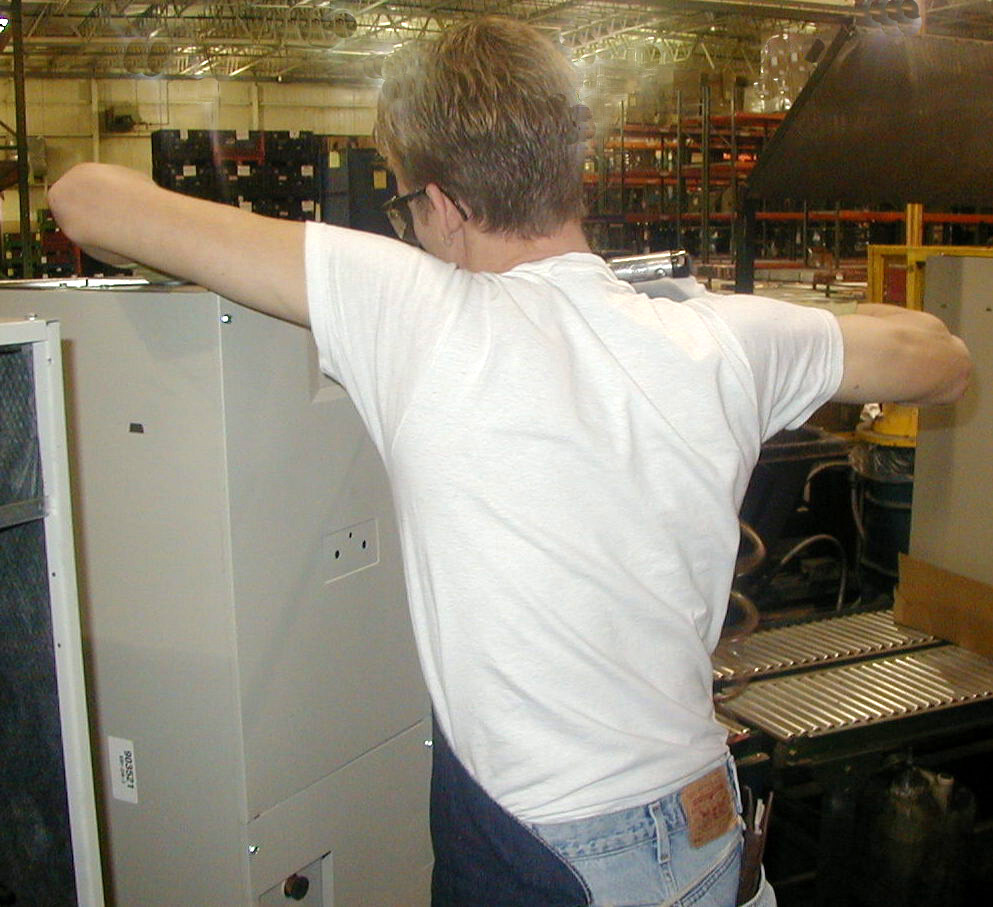 |
| Too low | Too High |
A common workplace problem is a mismatch in heights between people and the work that they are doing. This condition can make work unnecessarily harder.
Production issues
In repetitive jobs, bending down and reaching up can waste a surprising amount of time. In some cases, inability to reach can hamper production considerably. Reaching excessively high or low increases the risk of dropping and damaging an item. Finally, working at the wrong height causes awkward working postures — primarily bent back or elevated arms — which in turn leads to fatigue and reduces strength and dexterity, as discussed in Posture.
Employee well-being
Reaching up or down to excessively high and low locations can increase the risk for over-exertion injuries, especially if heavy forces are involved. Constant bending or elevating the arms can be fatiguing, a source of temporary discomfort and pain, and a risk for long term disorders.
There are five categories of common height issues. Each has a range of options for improvement depending upon the situation:
Strategies for Improvement
Wrong for everyone – extremes
Optimal work height for individual
Accommodating different height individuals
Heights of consumable stacks of materials
Height relationships within equipment
Measurements
1. Wrong for everyone — Extremes
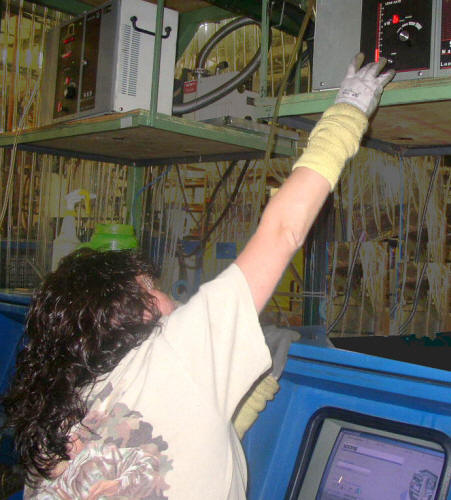 |
 |
| Beyond fingertip | Below standing surface |
Sometimes the working height is wrong for everyone, no matter what their stature. For example, in the illustration at right, the top racks of the shelf are too high for even the tallest people. The lowest racks are too low for even the shortest people. See Workstations: Storage, Height adjustment, Free-standing fixtures
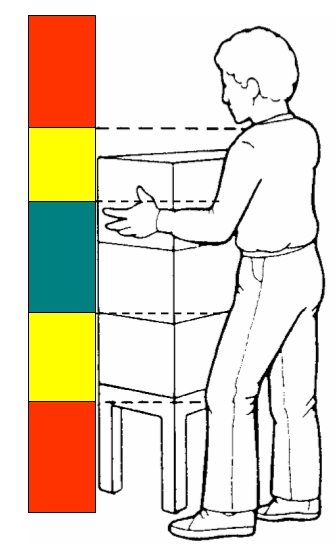 |
| Green, yellow, and red zones |
A good rule of thumb is to divide space into three approximate zones. The green zone is at roughly elbow or waist height (see below). The red zone is above the shoulders and below the knees. The yellow zone is everything in between. Ideally, most work should be done in the green zone and never in the red zone. This is not always possible, but it is a good way to think about your objectives.
 |
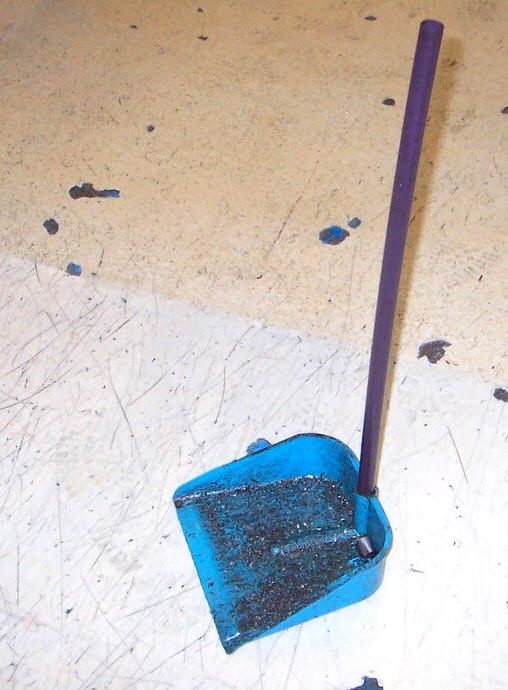 |
| Example: Long-handled dust pan | |
There are countless ways to improve working height. The example shown above affects probably everyone. Bending over to use a standard dustpan is at a “wrong” height for everyone. The long handle enables working upright.
2. Optimize for individual
Design for elbow height
(but see exceptions below)
 Generally, a good tip is that work is best done at about elbow height, whether sitting or standing. Note that it is the work itself that should be at elbow height, not necessarily the work surface (a big product placed on an elbow height surface is likely to be too high).
Generally, a good tip is that work is best done at about elbow height, whether sitting or standing. Note that it is the work itself that should be at elbow height, not necessarily the work surface (a big product placed on an elbow height surface is likely to be too high).
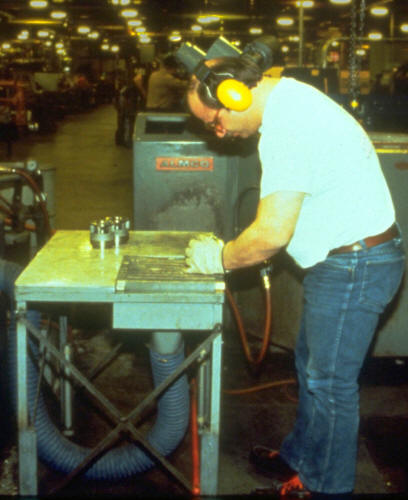 |
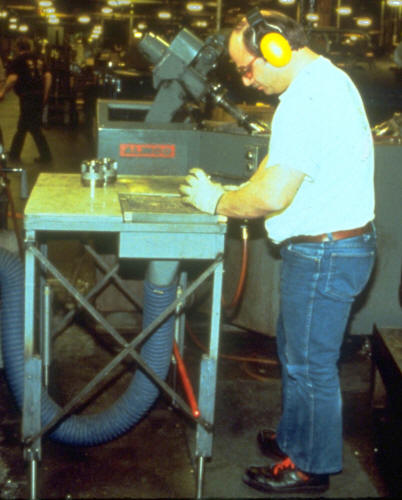 |
| Before: Too low, bent back | After: elbow height, back straight |
The basis for this general rule is that when working at elbow height, posture will generally be good, that is, no bending, no hunching of shoulders, etc. Furthermore, the arms and hands will generally be in the best position for arm strength and dexterity.
The photos above show this effect:
- Before: Note the bent back and the nearly horizontal position of the neck. Then note that the work (position of the hands) is below elbow height.
- After: The table has been raised, the back is straight and the neck is better. Now check the position of the hands relative to the elbow — they are level.
- (Continuous improvement: A slanted surface might help the neck and a footrest would be good for the back and legs.)
Thus, elbow height is a good tip for establishing heights in order to achieve a good working position. But to be clear, elbow height is not the point— the hand and the elbow do not necessarily need to be level. Elbow height is just a good pointer.
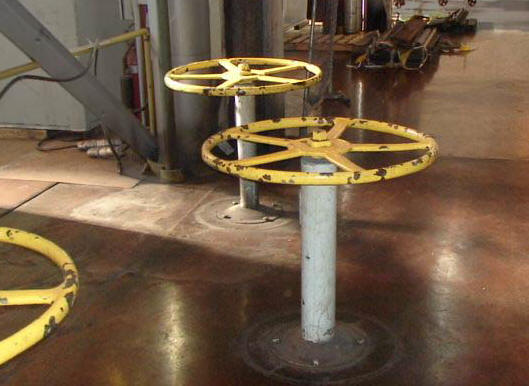
Elbow-high valve wheels
As another example of the general elbow-height rule, the photo above shows valve wheels in a power plant. All too often, wheels like this are too low to the ground, so the elbow-height rule provides good general guidance. (Note also the large diameter of the wheel to provide leverage, plus the excellent clearance to access the wheels.)
Critical exceptions
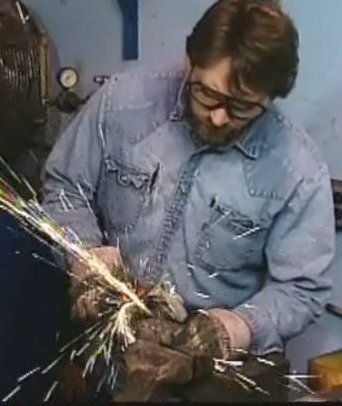 |
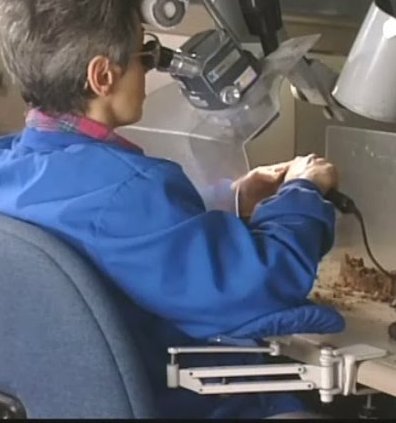 |
| Heavier work: Lower | Visual work: Higher |
The nature of the work also affects the proper height. Elbow height is not always optimal.
- Heavier work should generally be lower than elbow height so that it is possible to take advantage body weight and larger muscle groups of the torso.
- Lighter work, such as precision work or inspection tasks that are visually intense, should be higher so that you can see better. (Note that arm supports are often helpful in these situations.)
Sometimes the only way to know is to experiment with several options by setting up an adjustable mock workstation. Or sometimes you can try the job yourself and/or ask people who are experienced in doing the job. See Workstations: Height adjustment, Free-standing fixtures; Standing platforms
3. Accommodate people of different stature
Best: Change the work
 |
 |
| For one person | For several people |
The best approach is to adjust the height of the the equipment or work surface. This approach is easiest with only one person per workstation, which can then be adjusted once for that person, for example, by lengthening or shortening the legs of a workbench.
It is more complicated if several people use the same workstation, but still feasible. Placing a simple riser or work surface platform can sometimes accommodate taller people. Fixtures can serve the same purpose. More elaborate is a crank-up or push-button adjustable surface. See: Material handling: conveyors, carts; Workstations: bench fixtures, parts handling,
 |
| Unloading poultry truck |
One of the most outstanding examples of adjusting work height to fit people is unloading a poultry truck of the type commonly seen on highways with stacks of cages. The truck drives into the processing plant and stops on a large hydraulic lift in between two high work platforms. At this level, the top level of cages is at about elbow height for the employees working up on the platform. When the cages at the top level are empty, they raise the truck so the next level is at a good work height. They continue until the bottom level is empty, the truck high in the air and the employees still working at about elbow height.
Second best: Standing platforms
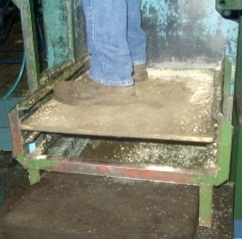 |
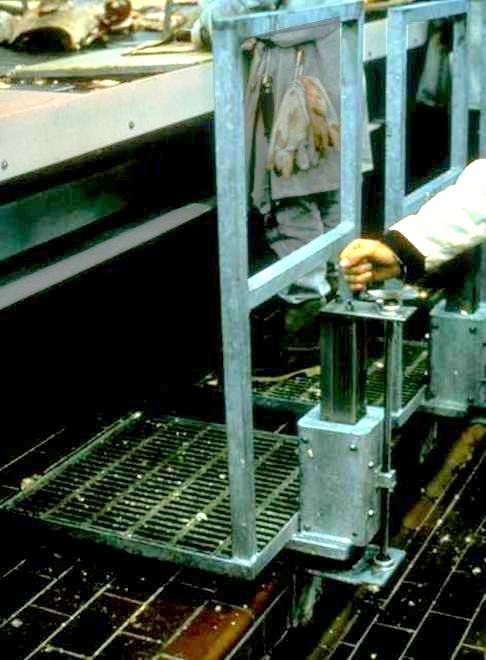 |
It is not always feasible to adjust the height of the work. For example, it is usually impossible to raise and lower assembly lines or large pieces of equipment. The alternative, then, is usually to provide step platforms. Unfortunately, step platforms can create congestion and possible tripping hazards, they are clearly a secondary choice. See Workstations: Standing platforms
4. Stacks of consumable materials
It is common within all of industry to have stacks of materials that are at different heights as materials are consumed or added. Thus, at times the height is good, but at other times too high or too low.
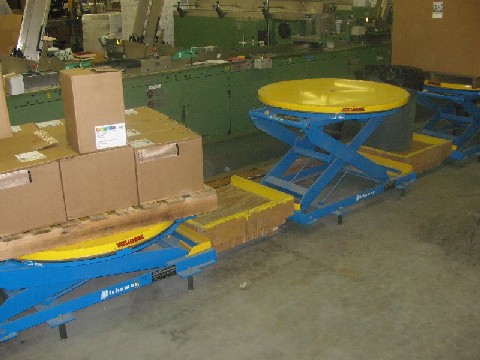 |
 |
The standard solution strategy is to use adjustable carts, stands, and lifts of various types. A wide variety of styles and options are available that can fit almost any situation.
See Material handling: Lifts, Carts, Lifter-Transporters, Containers, Tilters; Workstations: Parts handling, Storage
5. Height relationships within equipment — Design to slide
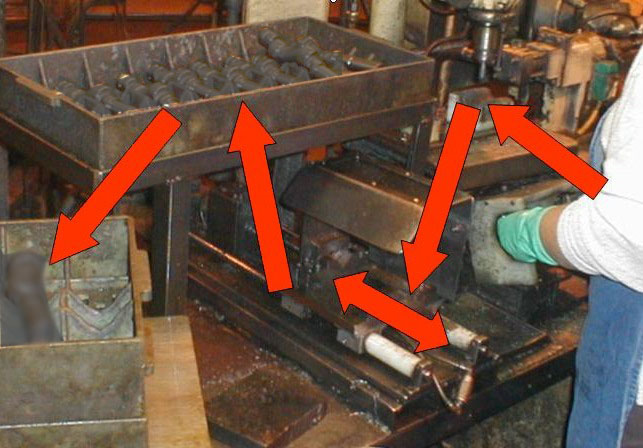 |
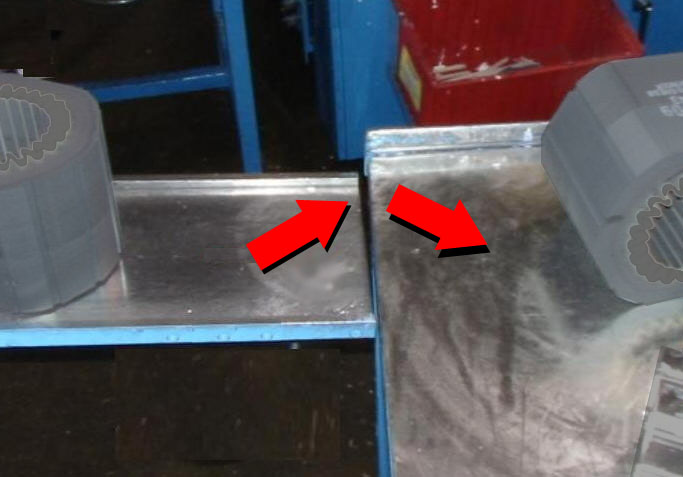 |
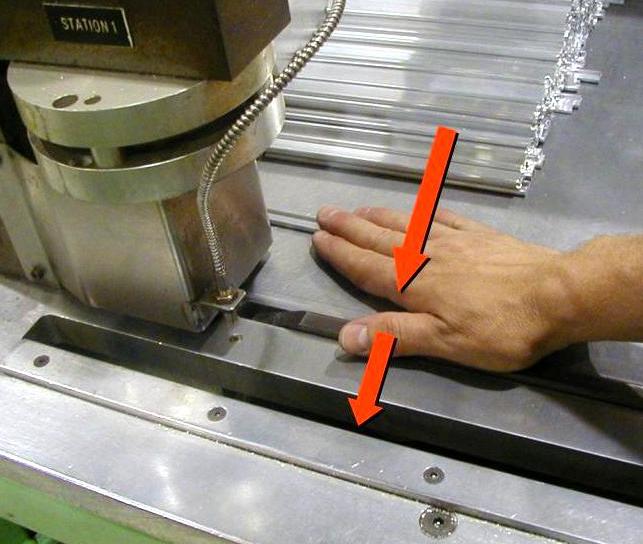 |
| Very poor: Dramatic height differences | Poor: Small lip prevents sliding | Good: Designed for sliding |
It is almost always better to slide a load than pick it up and put it down. Having two or more different heights within the workstation can inhibit sliding. Surfaces need to be at the same level. Material handling: Slides, Conveyors Workstations: Parts handling.
Measurements:
See Anthropometry
– – –
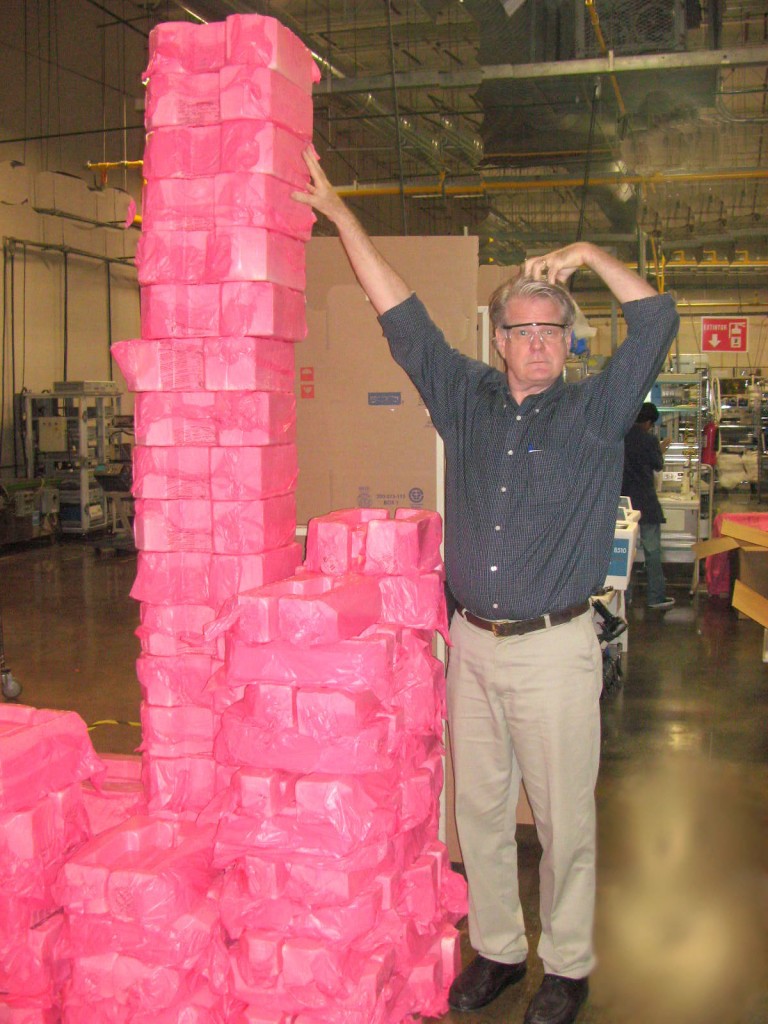 |
| Author (6′ 3″) conducts technical analysis of workplace height issue |
